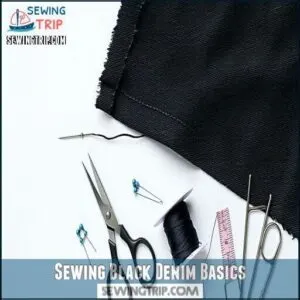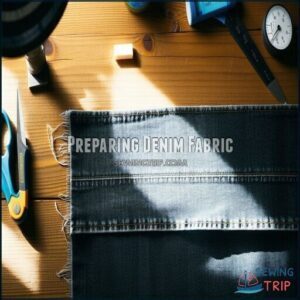This site is supported by our readers. We may earn a commission, at no cost to you, if you purchase through links.

Use sharp scissors for clean cuts, and heavier-duty needles (try size 90/14 or 100/16) to handle the tough fabric. Opt for polyester thread since it’s strong and blends well.
Set your sewing machine to a longer stitch length—denim needs room to breathe. Press seams as you go and use a hump jumper or scrap fabric to glide over thick seams.
Patience is key; denim rewards careful hands. Want pockets and hems that wow? There’s more to discover as you dive deeper, and with careful hands, you can achieve professional results.
Table Of Contents
Key Takeaways
- Prewash black denim to prevent shrinking and use a vinegar rinse to set the dye and maintain color.
- Use strong jeans needles (90/14 or 100/16), polyester thread, and adjust your sewing machine for thicker fabric with longer stitches.
- Manage bulky seams with a hump jumper, press seams flat with steam, and reinforce high-stress areas like pockets with bar tacks or rivets.
- Go slow on thick layers, topstitch for durability, and use sharp tools for clean cuts and precise sewing.
Sewing Black Denim Basics
You’ll need quality denim needles and sturdy thread before tackling that sleek black denim that’s been intimidating you from your fabric stash.
With the right tools and a bit of preparation, you’ll transform that midnight fabric into professional-looking jeans that’ll have friends asking where you bought them.
Turn that midnight fabric into stunning, professional jeans that everyone will swear are straight from a designer boutique!
Choosing Right Denim Fabric
How do you pick the perfect black denim for sewing?
Start with fabric weight—lightweight for soft flow, heavyweight for structure.
Check the stretch factor: black stretch denim has added elastane, while nonstretch denim offers firmness.
Fiber content affects durability; 100% cotton lasts long.
Reliable fabric sources matter—shop quality black denim to guarantee your jeans shine.
Essential Tools for Sewing Denim
When sewing black denim, your toolkit matters.
Use sharp fabric scissors for clean cuts and seam rippers to fix mistakes.
Denim needles (size 100/16) prevent breakage, while a Hump Jumper helps with bulky seams.
Choose the best thread for denim—heavy-duty for topstitching and all-purpose for seams.
A strong sewing machine guarantees smooth stitching.
For specialized projects, consider using specific needle types for superior results.
Master these denim sewing tips!
Preparing Denim for Sewing
Once your tools are ready, it’s time to prepare your denim fabric properly.
Prewash the black denim to reduce shrinkage and stabilize its texture.
Align the grain direction carefully while laying out your fabric.
Use marking tools like tailor’s chalk for precision. For cutting, sharp scissors or a rotary cutter work best to guarantee clean, accurate edges.
How to Sew Black Denim
Sewing black denim can feel tricky, but it’s easier with a few smart techniques. Black denim fabric requires precision to highlight its intense color and durable texture.
Master the art of sewing black denim—precision transforms its bold color and toughness into stunning, professional creations.
Start with the right setup:
- Thread and Hardware: Match thread color to the fabric for sleek seams, or go bold for contrast. Opt for sturdy rivets, zippers, and buttons to balance durability with flair.
- Topstitching Techniques: Use heavy-duty thread or double your regular thread for visible, clean lines. Take your time stitching to guarantee accuracy.
- Handle Bulky Areas: A Jean-a-ma-jig or folded paper can keep seams even. Press seams flat and consider a hammer for ultra-thick spots. To avoid puckering, a walking foot helps.
Distressing black denim adds personality—experiment with sandpaper or washing to achieve that lived-in look.
Denim Fabric Selection
Choosing the right denim fabric sets the foundation for great jeans, so you’ll want to pay attention to weight, stretch, and durability.
Whether you prefer classic non-stretch or flexible stretch denim, understanding their differences helps you pick what works best for your project.
Denim Weight and Stretch
Understanding fabric weight and stretch is key when sewing black denim.
Lightweight options offer sewing ease but lack denim durability.
Heavyweight denim is sturdy yet harder to handle.
The stretch percentage impacts comfort and garment suitability—nonstretch denim guarantees structure, while stretch denim adds flexibility.
Choose based on your project’s needs, balancing style, function, and the challenges of working with denim weight.
Raw denim sizing requires consideration, as natural fibers stretch over time, affecting the overall denim durability and sewing ease.
Non-Stretch Vs Stretch Denim
Choosing between stretch denim and non-stretch denim depends on comfort level, durability differences, and project suitability.
Stretch denim blends offer fabric recovery and flexibility, ideal for close fits.
Non-stretch denim, with tighter weave density, provides a sturdy, classic structure perfect for custom pieces.
For black denim sewing, balance fabric weight and movement needs for your DIY project goals, considering the durability differences.
Where to Buy Denim Fabric
Finding great denim fabric starts with exploring online retailers for variety and convenience.
Many sewers prefer online options for convenience. Use a denim fabric guide to compare quality, ensuring your sewing denim fabric matches your project perfectly.
Local shops let you feel fabric weight and assess denim types in person. Budget options, like thrift stores or swaps, can offer hidden gems for black denim sewing, which is a great way to find denim fabric.
Preparing Denim Fabric
Before you start sewing, you’ll need to get your denim fabric ready for action.
Prewash, press, and cut it carefully to keep shrinking, fraying, and uneven edges from causing headaches later.
Prewashing and Drying Denim
Before sewing denim, prewash black denim twice in cold water to combat shrinkage and color fading.
Use a mild detergent, avoiding harsh chemicals. Choose a water temperature of 40°C (104°F) for accurate results.
Air-drying works best to prevent shrinking, but tumble dry low if necessary.
Properly prewashed denim guarantees your sewing projects fit perfectly and last longer. For best results with natural fibers, consider lukewarm water usage to achieve the desired outcome with natural fibers and ensure a perfect fit by following these prewashing steps.
Pressing Denim Fabric
Pressing black denim isn’t just ironing—it’s shaping your masterpiece.
To guarantee crisp seams and a polished look, follow these steps:
- Use a pressing cloth to prevent shine.
- Set your iron to cotton with steam.
- Flatten bulk with a seam flattener.
- Press seams open for strength before topstitching.
Proper pressing turns good sewing into great denim!
Cutting Denim Fabric
Once your denim fabric is pressed, it’s time to cut.
Lay it flat, ensuring proper grain alignment for neat seams. Use sharp cutting tools like fabric scissors or a rotary cutter for accuracy.
Employ precise marking methods like chalk to trace patterns. Pay attention to pattern placement to minimize fabric waste.
Clean fabric cutting sets the stage for seamless black denim sewing techniques.
Sewing Denim Techniques
When sewing denim, you’ll need to adjust your technique to handle its thickness and strength.
With the right tools and a few simple tricks, you can master sewing even the bulkiest seams like a pro.
Machine Stitching Denim
To tackle thick denim sewing like a pro, pick jeans needles and adjust foot pressure to prevent jams.
Set the stitch length to 3mm for smooth, strong seams. Tension adjustment matters—test stitches first!
For bulky seams, try seam hammering or use a “Jean-a-ma-jig.”
A steady pace guarantees clean sewing machine denim results, even on tough, dark denim projects.
Hand Sewing Denim
Patience and precision shine in hand sewing black denim.
Choose a thick needle, waxed thread, and a sturdy thimble for tough denim layers.
Follow these tips:
- Use small backstitches for strength and durability.
- Pull the thread taut but not too tight to prevent puckering.
- Press seams after stitching for a polished finish.
Dealing With Bulky Seams
Thick denim seams can test your patience, but tools like Hump Jumpers and Jean-a-ma-jigs make it easier.
Flatten bulky areas by hammering seams or reducing layers.
Protect your needle with slow, steady sewing over tough spots, and manage seam allowance neatly with flat felled seams or trim carefully for bulk reduction.
Bulk-busting feels rewarding once those smooth stretches emerge!
Denim Seam and Stitch
When sewing black denim, getting clean, durable seams is key to a polished finish.
Focus on sturdy techniques like flat-felled seams or serging to manage fraying and keep your jeans looking sharp.
Flat Felled Seams
For durability and aesthetics, flat felled seams are a go-to in denim sewing.
They’re strong, clean, and straightforward to learn. Fold, press, and topstitch for a pro finish that stands up to everyday wear.
These seams excel in jeans construction, providing both style and strength. Use this technique for applications like inseams and yokes, where durability meets polished design.
Serging and Overlocking
When serging denim, adjust your serger settings for thicker fabrics, ensuring smooth stitches.
Use a strong thread for durability and set the differential feed to prevent puckering.
Serging curves requires patience—slow down for control.
Try rolled hems for a polished edge.
For enhanced durability, consider using a five-thread safety stitch.
These sewing techniques pair perfectly with your sewing machine, balancing strength and style while tackling even tough denim fabrics.
Sewing Denim Pockets
Pockets might seem simple, but sewing them correctly is key to both function and style.
You’ll learn how to create sturdy pocket bags, attach them neatly, and reinforce openings for durability.
Creating Pocket Bags
Pocket bags are all about structure and function.
Use a durable pocketing fabric to sew the lining. Flip the pocket lining with the right sides together, sew a precise seam, and press it flat.
Reinforce edges by topstitching. Want a polished look? Add decorative stitching or rivet placement at stress points.
This strengthens pocket shapes and enhances durability.
Attaching Pockets to Denim
Start by carefully marking your pocket placement for symmetry.
Pin the pocket to the denim, ensuring smooth edges and no puckering.
Use denim pocket sewing techniques like double topstitching or decorative stitching for durability and style.
Reinforce corners with backward stitches, or add rivets for strength.
Gently guide the fabric over thick layers to keep back pockets secure and precise.
Reinforcing Pocket Openings
To reinforce pocket openings effectively, focus on these three tips:
- Add bar tacks or lockstitch tacks at stress points like the corners of back pockets.
- Use interfacing options for fabric reinforcement underneath pocket edges.
- Experiment with topstitching patterns for extra strength and style.
This guarantees longevity in your denim pocket sewing, even with heavy use.
Hemming Black Denim
Hemming black denim gives your jeans a polished finish, whether you go for a sleek double-turn hem or a trendy frayed edge.
With the right tools and a bit of patience, you can create sturdy, clean hems that look and feel professional.
Frayed Hem Technique
A raw edge hem adds character to black denim.
To fray, snip 1" below the new hemline and roughen the edges lightly.
Secure fray with a stitch 1 cm above the raw edge for durability.
Here’s a quick guide:
| Step | Tools Needed |
|---|---|
| Measure Length | Measuring Tape |
| Mark Hemline | Chalk or Marking Pen |
| Cut Edges | Sharp Fabric Scissors |
| Secure Fray | Sewing Machine, Jeans Needle |
| Style & Finish | Steam Iron |
The process involves several key steps, including Measure Length, Mark Hemline, and Secure Fray, to achieve a raw edge hem.
Double Turn Hem
A double turn hem gives your black denim jeans a durable, clean finish.
Fold the hemline under twice, about an inch each time, to manage hemming thickness and prevent fraying.
Secure it with matching topstitching for seamless hem aesthetics, which reinforces the hem while adding a polished touch, showcasing your denim hemming mastery.
Sewing black denim just got smoother!
Pressing Denim Hems
Pressing is key in finishing hems like a pro.
Steam pressing sets curved hems, reduces bulk, and prevents puckering—especially with tricky black denim.
Use hem interfacing for stability, and always press with the iron’s cotton setting.
For clean edges, try mitered corners or blind hems.
Perfect pressing elevates your denim hemming techniques, giving your sewing project a polished, professional touch.
Finishing Denim Seams
Finishing denim seams keeps your jeans looking professional and prevents fraying over time.
By using interfacing, serging edges, and pressing your seams, you’ll guarantee a clean, durable finish that holds up to wear and washing, ensuring a professional look.
Using Interfacing for Denim
For structured areas like waistbands, sewing interfacing helps add stability to black denim.
Choose interfacing types based on denim weight—fusible works well but avoid bubbles by pressing evenly.
Cut interfacing slightly smaller than the denim piece to prevent overlap.
Application methods matter: fuse to the wrong side using a medium-hot iron. It’s a tiny step with big impact!
Serging Denim Edges
After applying interfacing, it’s time to focus on your serger.
Use durable thread and adjust your Serger Settings for thicker denim.
Check the Blade Maintenance and tweak the Differential Feed to prevent puckering. Serger product options can further enhance your results.
Overlocking keeps seams stable, while Rolled Hems aren’t ideal here.
Keep your sewing machine steady—serging denim edges gives your project a polished, professional look.
Pressing Denim Seams
After serging denim edges, it’s time to tame those seams.
Use a hot iron set to the cotton setting with steam. A pressing cloth prevents shine on dark denim.
Flatten seams gently, guiding the iron without stretching the fabric. This step guarantees a professional finish, keeping your sewing tips handy to tackle any tricky denim sewing seams with confidence.
Caring for Denim Projects
Taking care of your finished denim projects guarantees they last longer and stay in great shape.
From washing to storage, a few simple habits can keep your black jeans looking sharp and feeling sturdy.
Washing Denim Garments
Your black denim masterpiece needs TLC! Proper washing keeps it looking sharp.
- Wash Frequency: Wash sparingly to prevent fading, every 5-6 wears works best.
- Water Temperature: Use cold water to minimize shrinkage or color loss.
- Detergent Choice: Pick a mild detergent without bleach for gentle cleaning.
- Drying Methods: Air-dry inside out to avoid unnecessary wear.
Maintaining Denim Color
Keeping the rich hue of your black denim intact requires smart care.
Try vinegar in the final rinse during prewash to set the dye. Wash cold to avoid color bleeding and limit laundry days. Store away from direct sun exposure, as UV rays steal vibrancy fast.
Follow these black denim sewing tips for longevity and style.
| Tip | Why It Works | How To Do It |
|---|---|---|
| Vinegar trick | Sets dye, prevents fading | Add a cup of vinegar to the rinse cycle |
| Avoid hot water | Reduces color bleeding | Always wash in cold water |
| Protect from sun | Stops UV damage | Store in a cool, shaded space |
Storing Denim Projects
To protect your sewing black denim projects, store them right.
Avoid humidity, which invites pests, and keep fabrics away from direct light.
Acid-free storage options are great for ensuring longevity.
When deciding between folding vs. hanging, folding works best for heavy denim to prevent stretching.
- **Check humidity levels regularly.
- **Use pest deterrents like cedar blocks.
- **Keep storage areas dark and dry.
Frequently Asked Questions (FAQs)
Can I sew denim on a regular sewing machine?
You can absolutely sew denim on a regular sewing machine.
Use a jeans needle, adjust tension for smoother stitches, and sew slowly over thick seams.
A hump jumper or folded paper can help navigate bulky areas.
Is denim difficult to sew?
Sewing denim isn’t as hard as it’s hyped up to be.
With sharp tools, strong needles, and patience, you’ll tackle its bulk.
Just prep well, go slow over thick spots, and you’re golden!
How to stop black jeans from bleeding?
To stop black jeans from bleeding, wash them inside out in cold water with mild detergent.
Add white vinegar or salt to the rinse cycle to set the dye.
Always air-dry to lock color.
What is the best stitch for sewing denim?
Choosing the perfect stitch for denim feels like finding the right tool for the job.
Use a sturdy straight stitch (5-3mm length) for construction and opt for topstitching thread with longer stitches for decorative seams.
How do you sew denim?
Start by prewashing the fabric to prevent shrinking.
Use sharp scissors, a denim needle, and heavy-duty thread.
Sew with longer stitches for thick seams.
Press as you go, and topstitch for a durable finish.
Can you sew denim in a sewing machine?
Think of your sewing machine as a workhorse; yes, it can handle denim.
Use a heavyweight needle, sturdy thread, adjust the tension, and sew slowly over thick seams.
With care, it’s manageable!
How do you sew a workout denim?
Sewing workout denim requires precise techniques.
Use stretch denim and align the grainline for flexibility.
Select a stretch needle and polyester thread for durability.
Adjust tension and stitch length, and don’t rush over bulky seams.
Can you sew denim fast?
Yes, you can sew denim fast.
Use sharp scissors, a heavy-duty machine, denim needles, and prepped fabric.
Sew slowly over bulky seams, flatten them with a hammer, and streamline steps like topstitching efficiently.
How do you sew stretch denim jeans?
They say, "Measure twice, cut once."
Use stretch-specific denim needles, align the fabric’s stretch perpendicular to seams, reduce presser foot pressure.
Sew with longer stitches, and take your time around thick layers to avoid puckering.
Can a beginner sew denim at home?
Absolutely, you can sew denim at home, even as a beginner.
Use sharp scissors, denim needles, and prewash your fabric to prevent shrinkage.
Go slow over thick seams, and let your sewing machine guide you.
Conclusion
Mastering how to sew black denim is like crafting a timeless recipe—precision, patience, and the right tools make all the difference.
From prewashing your fabric to pressing professional seams, your attention to detail guarantees durable, stylish results.
Don’t rush; denim demands respect, and investing in quality materials like sturdy needles and polyester thread is crucial.
Invest in these materials, and let your sewing machine’s longer stitch length work its magic, with care and technique, you’ll transform simple denim into DIY jeans worth showing off!
- https://blog.closetcorepatterns.com/just-make-it-already-how-to-boost-your-sewing-confidance/
- https://www.blackbirdfabrics.com/en-us/blogs/resources/get-to-know-the-new-denim-project
- https://merchantandmills.com/us/the-heroine-pdf
- https://www.wawak.com/sewing/sewing-machine-accessories/machine-accessories/the-hump-jumper-18-116-2pack/
- https://www.instagram.com/kerukjeans/?hl=en

















